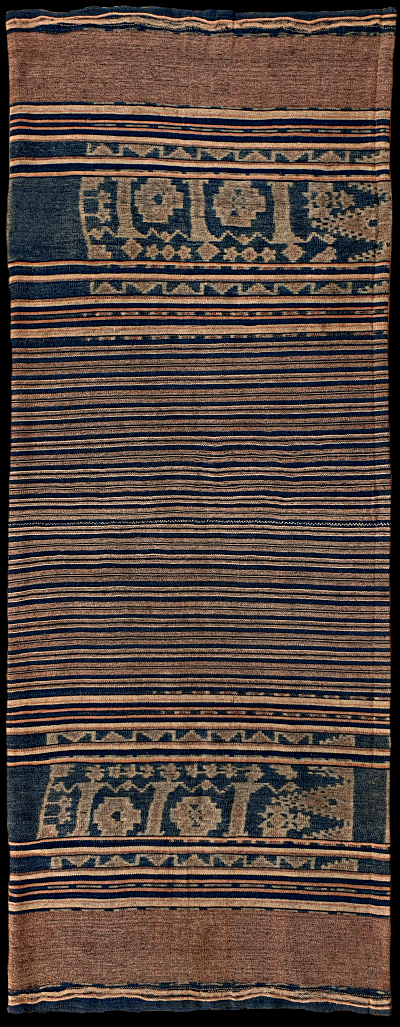| |
 
 | | | |
068 Solor Archipelago, Lembata
Kewatek (sarong) 
| | Locale: | Lembata, most likely the village of Kalikur | | Period: | 19th c. | | Yarn: | Cotton, hand-spun, medium | | Technique: | Warp ikat | | Panels: | 2 | | Size: | 60 x 157 cm (1' 11" x 5' 1") LW: 2.62 | | Weight: | 655 g (23.1 oz), 348 g/m2 (1.14 oz/ft2) | | Design: | This sarong, of a type called Tuka Dulang, has a field division which is often seen in the Solor & Alor Archipelago. The main ikated motif though, which represents three girls in ankle-length sarongs performing a dance, is very rare. The dance, called dolo dolo, was performed in a religious context, though our Lembatan informant was unclear whether this was before or after conversion to Christianity. (It may well be a ritual dance that predated conversion, and continued to be performed after.) The eight-pointed stars are quite common on Lembata, so are tumpal. Striped midfields on Lembata are found mostly on cloths made for the Kedang population group, a production part of which took place in Kalikur. The yellow, red, white and dark ochre pinstripes appear to have been done in commercial cotton, all the rest is hand-spun. | | Comment: | This type of cloth, Tuka Dulang, in olden days was used as belis, bridewealth. The tonality (reduced to pastel tones as a result of fading), is very similar to Lembata sarong PC 025, which was made for the non-weaving Kedang community, probably also in the coastal village of Kalikur, peopled by Muslim immigrants. According to our Lembatan informant's parents, the Kalikur weavers were taught weaving in Atawatung and Lamagute, small communities around Ili Ape, at the request of the king of Kalikur. (Curiously it is forbidden for Muslims to depict living beings, but as Kalikur is very far from Indonesia's main Muslim centers, this rule may not have been adhered to.) Tuka Dulang stopped being made six generations ago (though reportedly there is one Ili Ape weaver from Atawatung village who still makes them), and are now extremely rare, which explains why no other example was encountered in multiple decades of collecting. The early dating is undergirded by microscopic study of the yarn, which showed some of the most extreme yarn degradation ever observed. (Click on the little microscope to see.) | | Background: | Chapters on Solor Archipelago and Lembata. | | Compare: | 025 | | Sources: | No similar example known from the literature. Antoni Lebuan of Wisata Tenun Lembata provided the information on the name, origin and usage of this cloth. | | |

©Peter ten Hoopen, 2024
All rights reserved.
|
|


